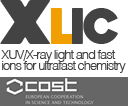| Name | Institution | Title |
|---|
| Lorenzo Avaldi |
Istituto di Metodologie e dei Plasmi (IMIP)-CNR, Italy |
Energy flow in molecules of biological interest studied by site and state selected fragmentation |
| Marie-Christine Bacchus |
Université de Lyon, France |
Ion-induced damage in DNA building blocks. Conformational analysis |
| Karine Béroff |
Institut des Sciences Moléculaires d’Orsay, France |
Fragmentation of multiply-charged carbon clusters and hydrocarbon molecules: branching ratios, KER and chemistry |
| Majed Chergui |
Ecole Polytechnique Fédérale de Lausanne, Switzerland |
Chemical dynamics in solutions probed using ultrashort UV, VUV and X-ray pulses |
| Raluca Cireasa |
Institut des Sciences Moléculaires d’Orsay, France |
Photo-induced Fragmentation of 5-Halouracils by VUV-XUV radiation |
| Rudy Delaunay |
Université de Caen Basse-Normandie, France |
Ion-induced reactivity in pyrene clusters |
| Nadja Doslic |
Department of Physical Chemistry, Rudjer Boskovic Institute, Croatia |
Almost all that goes wrong in the photoisomerization of the protonated Schiff base of retinal in solution |
| Michael Gatchell |
Department of Physics, Stockholm University, Sweden |
The Commissioning of the Double Electrostatic Ion Ring ExpEriment - DESIREE |
| Klavs Hansen |
University of Gothenburg, Sweden |
Transient hot electrons in clusters |
| Marie-Anne Hervé du Penhoat |
Université Pierre et Marie Curie, France |
Dissociation of ionized biomolecules: Influence of hydration. Ab initio molecular dynamics studies. |
| Paul-Antoine Hervieux |
University of Strasbourg, France |
On the recent progress in the modelling of the fragmentation of molecules and atomic clusters induced by collision with light and heavy projectiles |
| Loïc Journel |
Laboratoire de Chimie-Physique - Matière et Rayonnement, France |
Dissociation dynamics of highly charged molecular ions in core photonionization studied by momentum spectroscopy |
| Marta Labuda |
Gdansk University of Technology, Poland |
Charge transfer induced by collision of carbon ions with the heterocyclic organic molecules |
| Andreas Mauracher |
University of Innsbruck, Austria |
Charge transfer from excited helium anion to clusters in HNDs |
| Jordan Miles |
Queen's University of Belfast, United Kingdom |
Absorption Spectra and Ultrafast Decay Mechanisms of Gas Phase Green Fluorescent Protein Chromophores |
| Aleksandar Milosavljevic |
University of Belgrade, Serbia |
Photoionization of isolated charged proteins – the role of charge state and nanosolvation |
| Christophe Nicolas |
Synchrotron SOLEIL, France |
Relaxation dynamics of core-excited molecules: from diatomics to biomolecules |
| Dariusz Piekarski |
Facultad de Ciencias, Universidad Autónoma de Madrid, Spain |
Dynamics of Glycine Dications in the Gas Phase: Ultrafast Intramolecular Hydrogen Migration versus Coulomb Repulsion |
| Rita Prosmiti |
IFF-CSIC, Spain |
Theoretical simulations of the IR photodissociation spectra of H5+/D5+ cations |
| Ismanuel Rabadan |
Universidad Autónoma de Madrid, Spain |
Fragmentation of H2O+ in ion-H2O collisions |
| Ulf Saalmann |
Max Planck Institute for the Physics of Complex Systems, Germany |
Revealing Xray-driven dynamics in C60 from electron spectra |
| Thomas Schlathölter |
Kernfysisch Versneller Instituut, Nederlands |
Ionization and fragmentation of gas-phase peptides induced by keV ions and energetic photons |
| Camilla Skinnerup Byskov |
Dept. of Physics and Astronomy, Aarhus University, Denmark |
Statistical versus nonstatistical dissociation of peptide ions after photoexcitation |
| Jan Zabka |
J. Heyrovsky Institute of Physical Chemistry of the ASCR, v. v. i., Czech Republic |
Formation of negative ions from O+, HO+, H2O+ and H3O+ in high-energy collisions with molecules |

